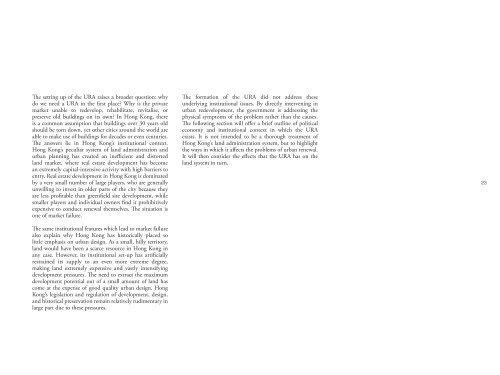Treating the Symptoms - A Critical Review of ... - Civic Exchange
Treating the Symptoms - A Critical Review of ... - Civic Exchange
Treating the Symptoms - A Critical Review of ... - Civic Exchange
- No tags were found...
Create successful ePaper yourself
Turn your PDF publications into a flip-book with our unique Google optimized e-Paper software.
The setting up <strong>of</strong> <strong>the</strong> URA raises a broader question: whydo we need a URA in <strong>the</strong> first place? Why is <strong>the</strong> privatemarket unable to redevelop, rehabilitate, revitalise, orpreserve old buildings on its own? In Hong Kong, <strong>the</strong>reis a common assumption that buildings over 30 years oldshould be torn down, yet o<strong>the</strong>r cities around <strong>the</strong> world areable to make use <strong>of</strong> buildings for decades or even centuries.The answers lie in Hong Kong’s institutional context.Hong Kong’s peculiar system <strong>of</strong> land administration andurban planning has created an inefficient and distortedland market, where real estate development has becomean extremely capital-intensive activity with high barriers toentry. Real estate development in Hong Kong is dominatedby a very small number <strong>of</strong> large players, who are generallyunwilling to invest in older parts <strong>of</strong> <strong>the</strong> city because <strong>the</strong>yare less pr<strong>of</strong>itable than greenfield site development, whilesmaller players and individual owners find it prohibitivelyexpensive to conduct renewal <strong>the</strong>mselves. The situation isone <strong>of</strong> market failure.The same institutional features which lead to market failurealso explain why Hong Kong has historically placed solittle emphasis on urban design. As a small, hilly territory,land would have been a scarce resource in Hong Kong inany case. However, its institutional set-up has artificiallyrestrained its supply to an even more extreme degree,making land extremely expensive and vastly intensifyingdevelopment pressures. The need to extract <strong>the</strong> maximumdevelopment potential out <strong>of</strong> a small amount <strong>of</strong> land hascome at <strong>the</strong> expense <strong>of</strong> good quality urban design. HongKong’s legislation and regulation <strong>of</strong> development, design,and historical preservation remain relatively rudimentary inlarge part due to <strong>the</strong>se pressures.The formation <strong>of</strong> <strong>the</strong> URA did not address <strong>the</strong>seunderlying institutional issues. By directly intervening inurban redevelopment, <strong>the</strong> government is addressing <strong>the</strong>physical symptoms <strong>of</strong> <strong>the</strong> problem ra<strong>the</strong>r than <strong>the</strong> causes.The following section will <strong>of</strong>fer a brief outline <strong>of</strong> politicaleconomy and institutional context in which <strong>the</strong> URAexists. It is not intended to be a thorough treatment <strong>of</strong>Hong Kong’s land administration system, but to highlight<strong>the</strong> ways in which it affects <strong>the</strong> problems <strong>of</strong> urban renewal.It will <strong>the</strong>n consider <strong>the</strong> effects that <strong>the</strong> URA has on <strong>the</strong>land system in turn.23
















